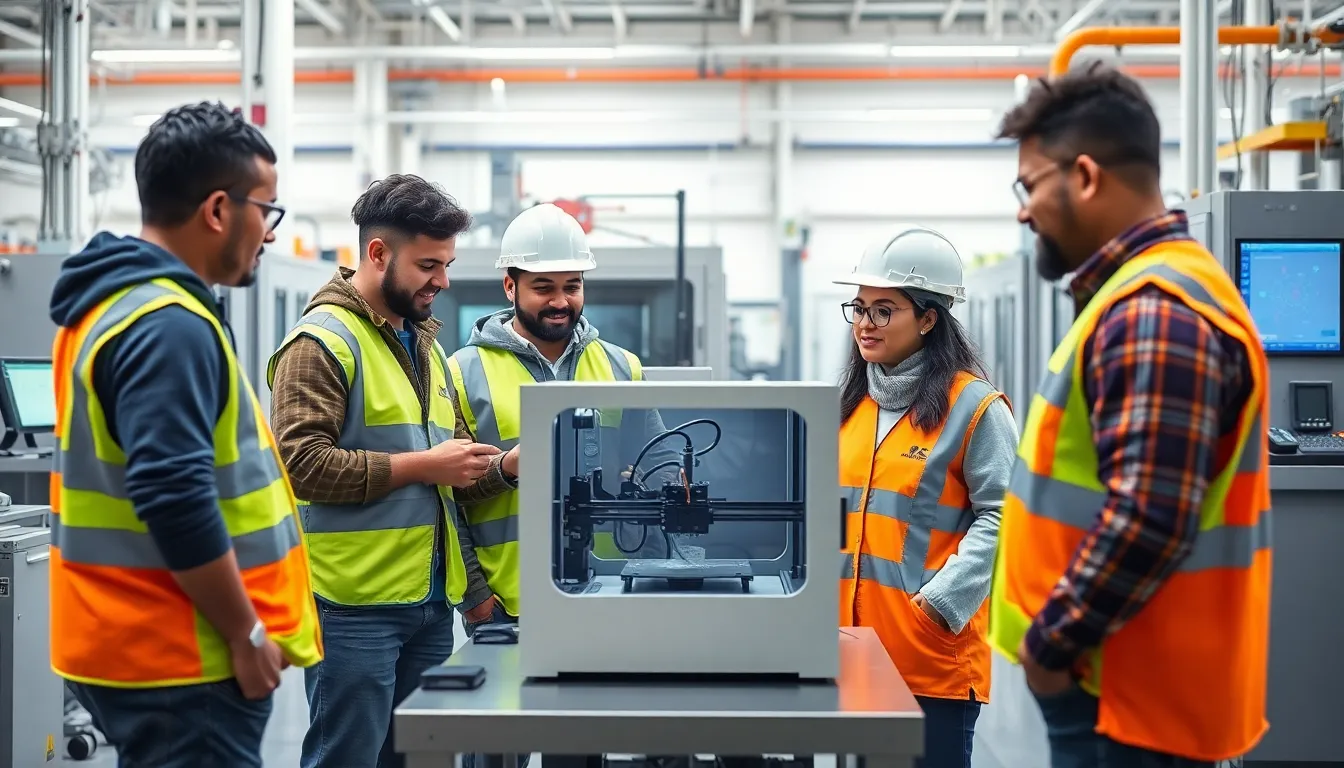Table of Contents
ToggleIn a world where engineering meets the future, emerging technologies are shaking things up like a toddler with a snow globe. From artificial intelligence to 3D printing, these innovations aren’t just buzzwords; they’re transforming how engineers solve problems and create solutions. Imagine building a bridge with a robot assistant or designing a skyscraper that can think for itself. Sounds like a sci-fi movie, right?
Overview Of Emerging Technologies
Emerging technologies are transforming the field of engineering, driving innovation and efficiency. Artificial intelligence (AI) is at the forefront, enhancing decision-making through data analytics and predictive modeling. Machine learning algorithms analyze large datasets, revealing insights that lead to improved project outcomes.
Additive manufacturing, commonly known as 3D printing, significantly reduces material waste while allowing for complex designs. This technology accelerates prototyping, enabling rapid iteration in product development. A notable example includes the aerospace industry, where 3D printing produces lightweight components, reducing fuel consumption.
Another advancement is the Internet of Things (IoT), connecting devices to enable real-time data exchange. Engineers leverage IoT in smart infrastructure projects, resulting in automated monitoring and maintenance. Sensors embedded in structures provide crucial information about load capacity and environmental changes.
Robotics, particularly drones and autonomous vehicles, revolutionize construction and surveying. Drones perform aerial surveys, saving time and increasing accuracy. Autonomous vehicles streamline material transportation, enhancing site productivity.
Virtual and augmented reality (VR/AR) also play pivotal roles in design and training. Engineers use VR for immersive simulations, helping teams visualize projects before implementation. AR aids in on-site guidance, reducing errors during installations.
Blockchain technology streamlines project management by enhancing transparency and security. Smart contracts automate processes, ensuring compliance and reducing delays in project timelines. This fosters collaboration among stakeholders, leading to efficient communication.
These technologies collectively reshape the engineering landscape, driving sustainability and innovation. As industries adopt these advancements, they pave the way for a more efficient and responsive engineering future.
Key Trends In Engineering

Emerging technologies profoundly influence engineering practices. Several key trends shape the future of this domain.
Artificial Intelligence And Machine Learning
Artificial intelligence enhances efficiency through advanced data analytics. Data-driven insights support better decision-making in project planning and execution. Machine learning algorithms adapt, learning from previous project outcomes to optimize future strategies. Benefits include reduced costs and improved timelines, evident in sectors like construction and manufacturing. Organizations leveraging these technologies can realize significant competitive advantages.
Internet Of Things (IoT)
The Internet of Things connects various devices for seamless data exchange. IoT applications enable real-time monitoring of infrastructure, leading to proactive maintenance and reduced downtime. Sensors integrated into structures provide critical performance data, enhancing safety and efficiency. Companies utilizing IoT systems can improve overall resource management and service delivery, driving operational excellence. Smart city initiatives demonstrate the transformative potential of IoT in urban environments.
Advanced Manufacturing Techniques
Advanced manufacturing techniques revolutionize traditional production methods. Additive manufacturing, commonly known as 3D printing, allows for rapid prototyping with minimal material waste. This technique fosters innovation by enabling intricate designs that were previously impossible. Industries such as aerospace and automotive benefit from these advancements, accelerating time-to-market for new products. Robotics also play a significant role, automating repetitive tasks and increasing precision in manufacturing processes.
Impact On Various Engineering Disciplines
Emerging technologies significantly influence various engineering disciplines, enhancing capabilities and efficiency across the board. The integration of these technologies leads to remarkable advances in project design, execution, and management.
Civil Engineering
Civil engineering experiences a transformation through the use of artificial intelligence and IoT. These technologies aid in predictive maintenance and monitoring of infrastructure systems, allowing for efficient resource allocation. Advanced materials, such as self-healing concrete, improve durability and reduce maintenance costs. 3D printing also enables the rapid construction of complex structures, minimizing waste and construction time. Drones provide real-time site assessments, enhancing data collection and safety. Enhanced design software facilitates better project visualization, improving communication among stakeholders.
Mechanical Engineering
Mechanical engineering sees a surge in innovation due to smart manufacturing and robotics. Automation not only streamlines production processes but also increases precision and reduces human error. Machine learning algorithms analyze performance data to optimize machine operations and energy consumption. Furthermore, additive manufacturing enables the creation of intricate components, supporting lightweight designs essential for efficiency. Virtual reality tools enhance training and design evaluations, allowing engineers to test concepts in immersive environments. These advancements collectively lead to increased productivity and reduced operational costs.
Electrical Engineering
In the realm of electrical engineering, advancements in IoT and machine learning play crucial roles in smart grid technologies. These innovations support real-time energy management and analytics for improved efficiency in power distribution. Renewable energy integration benefits from sophisticated software that predicts energy generation patterns, enhancing reliability. Advanced sensor technologies facilitate fault detection and monitoring in electrical systems, ensuring safety and functionality. Blockchain technology also enhances security in electrical transactions and grid communications, fostering a more resilient infrastructure. Continuous improvements in these areas pave the way for smarter energy solutions.
Challenges And Considerations
Emerging technologies present unique challenges and considerations that engineers must address to harness their full potential.
Ethical Implications
Ethical concerns arise as engineers adopt artificial intelligence and data analytics. Responsibility for data privacy and security takes precedence, especially when handling sensitive information. Engineers must consider the potential biases within AI algorithms that could lead to unfair outcomes. Additionally, transparency in decision-making processes becomes crucial to maintain public trust. Sustainability should guide the development and implementation of technologies, ensuring they benefit society while minimizing environmental impact.
Integration With Existing Systems
Integrating new technologies with existing systems poses significant challenges for engineers. Compatibility issues often surface when adapting legacy systems to modern solutions. Engineers face the task of ensuring seamless communication between old and new technology to avoid disruptions. Training team members on unfamiliar systems can also require substantial time and resources. Furthermore, gradual adoption strategies can help minimize operational risks, allowing for smoother transitions that enhance overall efficiency.
Emerging technologies are undeniably transforming the engineering landscape. With innovations like artificial intelligence and 3D printing at the forefront engineers are equipped to tackle complex challenges more efficiently than ever before. The integration of IoT and advanced manufacturing techniques is not just enhancing project outcomes but also paving the way for sustainable practices.
As these technologies continue to evolve engineers must remain vigilant about the ethical implications and challenges that accompany them. By prioritizing transparency and adopting gradual integration strategies they can ensure a seamless transition into this new era of engineering. The future holds immense potential for those willing to embrace these advancements and adapt to the changing environment.





